Abstract
This study aimed to investigate the impact of hydrogen content, up to 1217 ppm, on the mechanical properties of Zircaloy-4, with a particular focus on the formation and impact of hydrides. Tensile specimens were tested across a range of temperatures and hydrogen concentrations. The results revealed a pronounced ductile-to-brittle transition associated with hydride formation. When the hydrogen content in the specimens ranged between 700 and 850 ppm, a ductile-to-brittle transition was observed at temperatures of 25 °C, 50 °C, and 75 °C. At 25 °C, the ultimate tensile strength (UTS) of Zircaloy-4 linearly increased as the hydrogen concentration rose from 0 to 1217 ppm H. However, at higher temperatures, the behavior of UTS became more complex, especially in the hydrogen concentration ranges of 500–850 ppm H. Elongation (EL) in the hydrided specimens was affected by both temperature and hydrogen concentration. As hydrogen concentration increased, there was a noticeable decline in uniform EL, while non-uniform EL showed even more significant reductions. Scanning electron microscopy (SEM) analysis of the fracture surfaces revealed that quasi-cleavage features became evident when the hydrogen content reached 850 ppm H, across all tested temperatures. These findings not only provide a quantitative assessment of the safety implications of Zircaloy-4 in nuclear reactor applications but also highlight the importance of the hydrogen charging process and mechanical testing in understanding its mechanical behavior.
1. Introduction
Owing to their favorable strength to neutron absorption ratios and corrosion resistance, zirconium alloys are commonly employed as fuel cladding in nuclear reactors. In addition, it is known that the boiling water reactor (BWR) tie rods are fuel rods that have specially designed end plugs that are screwed into the lower tie plate and also affixed to the upper tie plate to provide structural support for the fuel assembly. Water rods provide additional moderation to BWR assemblies and provide axial positioning of the spacer grids. In other BWR design, the tie rods are displaced, and a considerable mechanical load on fuel rods during operation and handling is avoided. Instead, the water channel is used as a structural support for the fuel assembly. The materials used in this case are typically Zirconium alloys.
During reactor operation, zirconium alloys are exposed to reactive conditions such as irradiation, oxidation, and hydrogen absorption at varying temperature ranges [1]. However, hydrogen presence in these alloys can lead to embrittlement, affecting their lifespan [2]. As a result, the hydrogen content in zirconium alloys used in nuclear reactors plays a significant role in their mechanical properties. The primary source of hydrogen in zirconium alloys comes from the reaction of zirconium with water or steam, leading to rapid hydrogen production [3]. This reaction especially occurs during Loss of Coolant Accidents (LOCAs), characterized by a substantial rise in temperature [3]. During a LOCA, the cladding’s ability to maintain integrity is crucial. The DBTT is a significant factor in determining the cladding’s response to the rapid temperature changes and mechanical stresses experienced during such incidents. Suman et al. [4] explored the impact of hydrogen on the rupture behavior of Zircaloy-4 cladding during a LOCA, highlighting the criticality of understanding the DBTT in such scenarios.
Hydrogen can infiltrate zirconium alloys through multiple pathways, including moisture in fuel pellets, hydrogen produced due to water radiolysis, and the reaction of zirconium with coolant water [5]. Hydrogen can exist in two different states: in a solid solution within the zirconium matrix and as precipitated zirconium hydrides when the hydrogen content exceeds the solubility limit in the zirconium alloy [5]. The formation process of zirconium hydrides in these alloys is influenced by factors like temperature gradients and stress distribution within the material [6]. Temperature gradients can develop in the reactor core, creating conditions for hydrogen diffusion and hydride formation [6]. Additionally, the cooling rate and grain size also affect the distribution, morphology, and structure of zirconium hydrides, leading to variations in the phase and distribution of hydrides within the alloy [7]. The influence of hydrogen on the mechanical properties of structural alloys, including zircaloy, is strongly dependent on temperature [8]. Moreover, the uptake of hydrogen in zircaloy precipitates as brittle hydrides, which significantly affects the mechanical properties of zircaloy matrices [9]. Furthermore, a study utilizing a crystal plasticity finite element method modeling of zircaloy with hydride phases, based on scanning electron micrographs, demonstrated the effect of volume fraction and lamellae thickness of the hydride phase on the mechanical properties of the overall material [10].
In the operational phase of nuclear power plants, it is crucial to address not only the interaction between hydrogen and zirconium alloy cladding but also to assess the long-term effects of this interaction on Spent Nuclear Fuel (SNF) during the storage phase that follows reactor shutdown. The influence of hydrogen on fuel cladding may evolve during the storage period, affecting the safe and continuous containment of SNF. Currently, storage methods are categorized into wet and dry systems, with a trend shifting towards dry storage for its numerous benefits. Dry storage systems, recognized for their reliability and readiness for immediate implementation, primarily function based on passive safety strategies. A significant advantage of this storage approach is its long-term cost-effectiveness, coupled with the ability to transfer dual-purpose casks—suitable for both transportation and storage—directly to a final repository site [11].
The nuclear industry’s inclination towards higher fuel burnup levels for economic gains presents new challenges concerning the integrity of fuel cladding. Increased burnup may elevate hydrogen uptake and the internal pressure of the cladding, aggravating hydrogen embrittlement risks in Zircaloy cladding, especially during reactor service or the dry storage of SNF [8]. Moreover, in the context of extended dry storage, there is potential for hydride reorientation from hoop to radial direction as temperatures decrease below the DBTT, potentially exacerbating embrittlement [12].
Mitigating hydrogen embrittlement is essential for preserving cladding integrity. In response, the U.S. Nuclear Regulatory Commission (NRC) has issued Interim Staff Guidance-11, Revision 3 (ISG-11), which regulates that during normal storage conditions, the maximum temperature of cladding must not exceed 400 °C [13]. This limit is designed to prevent radial hydride formation, which could significantly increase the brittleness of fuel cladding, particularly after vacuum drying and subsequent cooling. The presence of hydrogen and the resultant formation of zirconium hydrides adversely affect the mechanical properties of zirconium alloys used in nuclear reactors [3]. Hydrides, being brittle in nature, contribute to material embrittlement [6], reducing ductility and the load-bearing capacity of the zirconium alloy, and thus raise operational safety concerns for nuclear reactors [14].
The aim of our research was to conduct an exhaustive examination of the influence of medium to high hydrogen content, up to 1200 ppm, on the mechanical attributes of Zircaloy-4 across a temperature spectrum from room temperature (RT) to 100 °C. This methodology was employed to emulate the mechanical responses of Zircaloy-4 in high burnup scenarios. Both the deformation behavior and fracture surfaces were systematically analyzed and characterized. In our endeavor to comprehend the extent of embrittlement in zirconium alloys, we have adhered to the precedents set by previous research [15,16,17]. These studies used a pronounced change in the reduction in area (RA) as a marker for the “ductile-to-brittle transition” (DBTT) in tensile-tested specimens. We maintain this definition in our current study.
2. Materials and Methods
The commercially available Zircaloy-4 material was utilized in this study. The composition of the material was 1.47 wt% Sn, 0.21 wt% Fe, and 0.10 wt% Cr, with the balance being Zr, while containing impurities of 1480 ppm O, 5 ppm N, 6 ppm H, and 138 ppm C. Sheet specimens in their as-received condition, with dimensions of 105 mm × 25 mm × 1.6 mm, were employed. Thermal cycling was employed to uniformly hydrogen-charge the Zircaloy-4 sheet specimens, reaching targeted hydrogen content levels of 600, 900, 1200, and 1500 ppm. The initial hydrogen charging temperature was set to 200 °C, with each thermal cycle incrementing by 10 °C until the maximum temperature of 300 °C was reached. A detailed description of the hydriding process is available elsewhere [18].
The inert-gas fusion method was used to determine hydrogen concentrations, using a HORIBA (EMGA-930) hydrogen analyzer (HORIBA, Ltd., Kyoto, Japan). The hydrogen concentration values reported were the average of at least three measurements. The targeted and measured hydrogen contents are summarized in Table 1. In investigating the mechanical behavior of Zircaloy-4 charged with hydrogen at four distinct levels, miniature tensile tests were utilized. Figure 1 provides a representation of the specimen’s geometry. The experiments were conducted at five set temperatures: 25 °C, 50 °C, 75 °C, and 100 °C. For those tests conducted above room temperature, a thermocouple was attached within the gauge length region of the specimen, enabling temperature control to be maintained within ±1 °C. Tensile testing was performed in air on both unhydrided and hydrided specimens, utilizing the MTS 810 Servo Hydraulic Testing System at an engineering strain rate of 3 × 10−4/s. The stress–strain curve derived from these tests allowed the ultimate tensile strength (UTS) and elongation (EL) to be determined. The reduction in area (RA) was calculated through a comparison of the dimensional changes between the original and ruptured tensile samples.

Table 1.
Hydrogen charging conditions of targeted, and measured hydrogen content in Zircaloy-4 sheets.
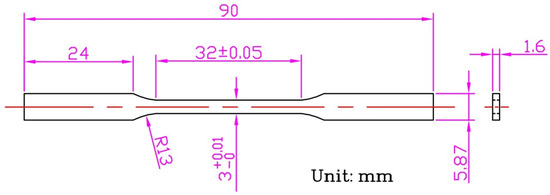
Figure 1.
Illustration of the tensile test specimen geometry.
3. Results
3.1. Ultimate Tensile Strength
Figure 2 presents typical stress–strain curves for samples with varying hydrogen content, tested at 25 °C. Each curve rises to a peak indicative of the ultimate tensile stress (UTS)—the maximum engineering stress the material can endure. Beyond the UTS, the material shows instability until fracture. Comparable patterns emerged when testing was conducted at different temperatures. Figure 3 shows the correlation between ultimate tensile strength (UTS) and hydrogen concentration. The value of UTS slightly increased as hydrogen concentration increased. As expected, UTS decreased with the increase in temperature. In the curve obtained at 25 °C, Zircaloy-4 is observed to display a linear escalation in the UTS, ranging from approximately 450 MPa to 540 MPa, as the hydrogen concentration varies from 0 to 1217 ppm H. For the specimens subjected to testing at 50 °C, an initial increase in UTS is noted from 0 to 500 ppm H, followed by a discernible reduction in the UTS in the hydrogen concentration interval of 500–700 ppm H. Beyond 700 ppm H, a resumption of the UTS increment is evidenced. A similar trend is manifest in the specimens evaluated at 75 °C, with the decline in UTS occurring in the hydrogen concentration range of 500–850 ppm H. Upon elevating the test temperature to 100 °C, the UTS is seen to initially rise, subsequently stabilize within the 500–850 ppm H range, and then experience a subsequent upturn upon reaching a hydrogen content of 1217 ppm.
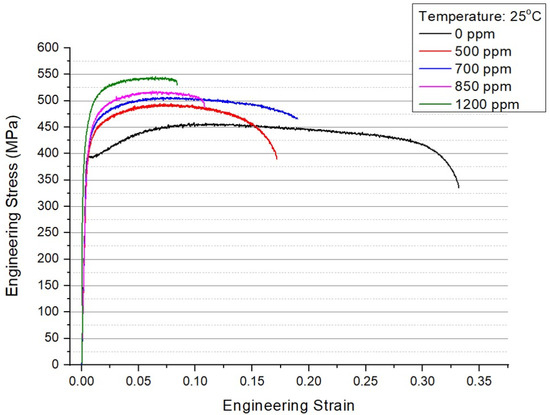
Figure 2.
Typical stress–strain curvets for unhydriding and hydriding specimens at 25 °C with varying hydrogen content.
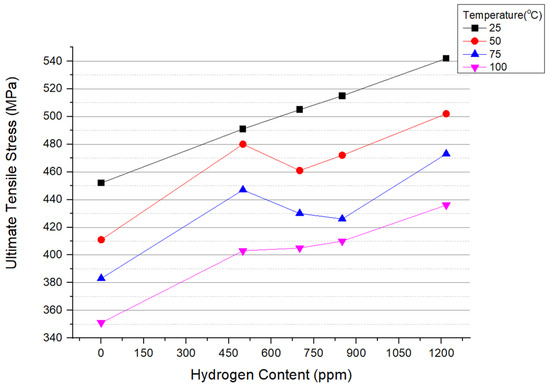
Figure 3.
Influence of hydrogen content on the ultimate tensile strength of Zircaloy-4 specimens across four different temperatures.
3.2. Reduction in Area and Elongation
Figure 4 elucidates the interplay between the reduction in area (RA) and varying hydrogen concentrations across multiple temperature conditions. At a constant temperature of 25 °C, the Zircaloy-4 alloy manifests a decremental trend in RA values, descending from 68% to 58%, as the hydrogen concentration escalates from 0 to 700 ppm H. Within the hydrogen concentration within 700–850 ppm H at this temperature, a conspicuous ductile-to-brittle transition is discerned. In the elevated temperature range of 50–75 °C, a comparable transition persists, despite attenuated RA value fluctuations. This could potentially signify a general susceptibility to reduced ductility for specimens incorporating hydrogen concentrations in excess of 850 ppm H when assessed over the temperature range of 25–75 °C. At a further elevated test temperature of 100 °C, Zircaloy-4 shows a graduate decrement in RA, ranging from an initial 68% to a value of 47%, concomitant with a hydrogen concentration increment extending from 0 to 1217 ppm H.
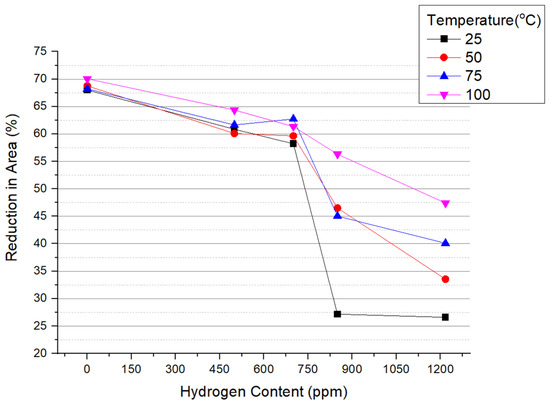
Figure 4.
Impact of hydrogen content on the area reduction in Zircaloy-4 specimens at four distinct temperatures.
Figure 5 delineates the correlation between elongation (EL) and hydrogen concentrations under variable thermal conditions ranging from 25 °C to 100 °C. The figure reveals two distinct regimes wherein a decrement in EL is evident as the hydrogen content increases. These regimes manifest within the hydrogen concentration intervals of 0–500 ppm H and 700–850 ppm H. Notably, EL in the specimens subjected to hydrogen concentrations ranging from 500 to 700 ppm H and from 850 to 1217 ppm H remains statistically invariant in the present study.
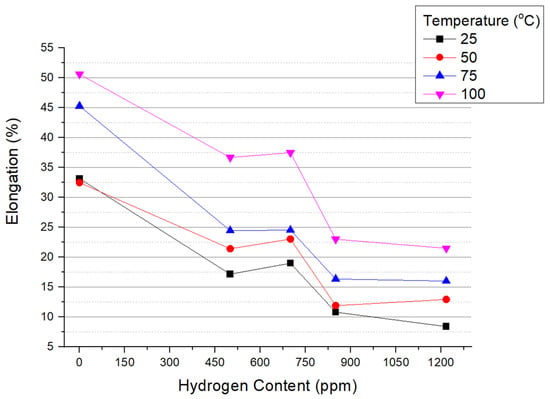
Figure 5.
Influence of hydrogen levels on the elongation of Zircaloy-4 specimens across four temperature ranges.
3.3. Optical Micrographs and Fractographs
Prior to conducting mechanical testing, the hydride distribution across the thickness of the specimens was characterized. Figure 6 presents representative micrographs illustrating the hydride morphologies at three distinct hydrogen concentration levels: 500, 850, and 1217 ppm H. The hydrides appear to be uniformly distributed throughout the material. It was observed that as the hydrogen concentration increases, the spacing between individual hydride platelets tends to decrease, indicating a more compact hydride structure at higher hydrogen levels.
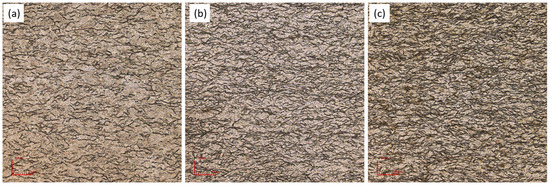
Figure 6.
Morphological characteristics of hydrides (appearing as dark lines) in Zircaloy 4 prior to testing; (a) with 500 ppm H, (b) with 850 ppm H, and (c) with 1217 ppm H.
Figure 7 presents scanning electron microscopy (SEM) (Thermo Fisher Scientific, Waltham, MA, USA) fractographs of specimens, each with varying levels of hydrogen content, all subjected to testing at a constant temperature of 25 °C. The unhydrided specimen predominantly exhibited a ductile fracture surface characterized by microvoid coalescence, as detailed in Figure 7a. For the specimen charged with 500 ppm H, the fracture mechanics were primarily ductile in nature but also featured a minor presence of secondary cracks, as highlighted in Figure 7b.
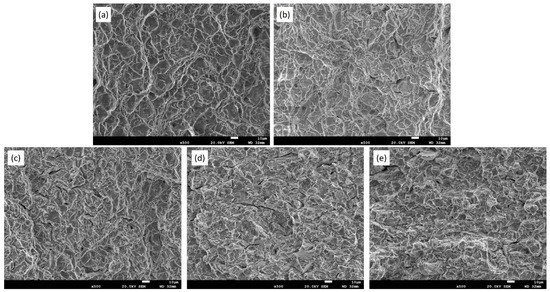
Figure 7.
SEM fractographs of Zircaloy-4 specimens at 25 °C: (a) non-hydrided; (b) with 500 ppm H; (c) with 700 ppm H; (d) with 850 ppm H; (e) with 1217 ppm H.
When the hydrogen concentration was elevated to 700 ppm H, the fractograph revealed an amalgam of secondary cracks, planar facets, and ductile fracture mechanisms, which are explicated in Figure 7c. It should be noted that both the spatial density and length of these secondary cracks are notably greater in Figure 7c compared to those depicted in Figure 7b.
For specimens charged with hydrogen concentrations exceeding 850 ppm H, the fracture surface morphology transitioned to quasi-cleavage features, accompanied by secondary cracking phenomena, as exhibited in Figure 7d,e. Such micrographs emphasize the increased susceptibility to brittle fracture mechanisms in Zircaloy-4, particularly around hydride inclusions or at the hydride–Zircaloy-4 interface, concomitant with elevated hydrogen content at ambient temperature.
Fractographs of the specimens tested at a temperature of 100 °C, as depicted in Figure 8, show the same trends observed for the specimens tested at ambient temperature. It was suggested by the results that the quasi-cleavage features remain unchanged for specimens tested at 100 °C when the hydrogen content exceeds 850 ppm H.
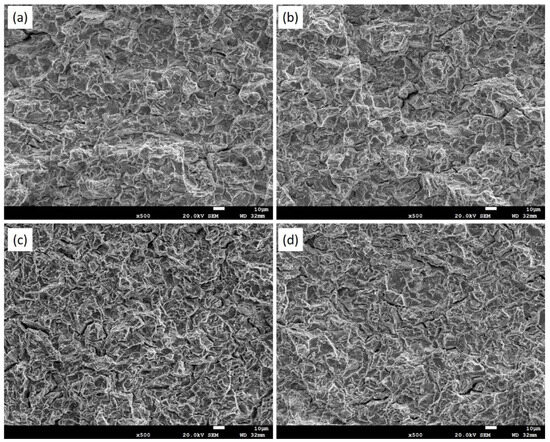
Figure 8.
SEM fractographs of Zircaloy-4 specimens charged with 1217 ppm H and tested at (a) 25 °C; (b) 50 °C; (c) 75 °C; (d) 100 °C.
4. Discussion
4.1. Tensile Behavior of Zricaloy-4
For specimens tested at ambient temperatures, an upward trend in UTS is observed, correlating with the increase in hydrogen content. This strengthening effect is attributed to the role of precipitated hydrides, which act as impediments to dislocation motion, thereby increasing the material’s strength. As anticipated, the UTS exhibits a decremental trend with elevated testing temperatures. However, an intriguing behavior is observed for specimens subjected to constant testing temperatures; for instance, at 50 °C, the UTS initially rises and then falls within the hydrogen concentration range of 500 to 700 ppm H, before subsequently increasing again. Similar trends are noted across other temperature ranges. Consequently, the presence of a softening mechanism is posited in the current experimental study.
This observed behavior can potentially be explained by a minor re-dissolution of hydrogen atoms from the hydrides at temperatures above 25 °C. These hydrogen atoms are postulated to interact with dislocations—the line defects in the crystal lattice that facilitate plastic deformation. According to Robertson et al. [19], hydrogen atoms can preferentially segregate to the stress fields surrounding dislocations, thereby modifying the local stress distribution and facilitating dislocation motion. This may lead to the observed reduction in the UTS. The impact of hydrogen content on the RA of Zry-4 is more pronounced than on its strength. A ductile-to-brittle transition is observed between 700 ppm H and 850 ppm H at temperatures ranging from 25 °C to 75 °C. Notably, the most distinct transition is evident in specimens tested at 25 °C, as shown in Figure 4.
4.2. Ductile-to-Brittle Transition of Zricaloy-4
The phenomenon of hydrogen embrittlement in zircaloy can be elucidated through the concept of hydrogen-enhanced localized plasticity (HELP). HELP is a mechanism for hydrogen-related fracture that has been extensively studied and is considered a significant factor in hydrogen embrittlement [20]. It involves the enhancement of dislocation mobility by hydrogen, leading to localized slip bands in the material under stress, ultimately resulting in embrittlement [21]. This mechanism has been observed in various materials, including zirconium alloys such as zircaloy, which are used in the nuclear industry for fuel claddings and reflectors in light water reactors [21].
The connection between hydrogen-enhanced plasticity and the hydrogen-induced fracture mechanism and pathway has been established through the examination of the evolved microstructural state immediately beneath fracture surfaces, including voids, quasi-cleavage, and intergranular surfaces [19]. Additionally, in situ observations by transmission electron microscopy have provided direct evidence for the enhancement of dislocation mobility associated with highly localized plasticity due to hydrogen [22,23].
A study by Alvarez et al. [24] quantified dislocation densities in zirconium hydride and observed a ductile-brittle transition in Zircaloy-4 when the hydrogen content exceeded a critical value, dependent on the alloy microstructure. This transition is closely linked with the development of a fully interconnected hydride network, as the volumetric expansion induced by hydride precipitation can generate tensile stress, prompting further hydride formation at the leading edges of pre-existing hydride structures. The existence of a critical hydrogen concentration is necessary for achieving this interconnected hydride configuration. Hydride precipitation in these alloys is a collective phenomenon, with interconnected events across various grains and/or grain boundaries (GBs) [25,26]. Figure 6c reveals that the hydrides, represented by dark lines, intersect with each other, indicating that they are interconnected. The presence of interconnected hydrides, particularly at hydrogen concentrations above 700 ppm, may be indicative of the overall DBTT behavior in Zircaloy-4. While the influence of testing temperature on this phenomenon is not evident from the RA data, it may correlate with the EL findings. This aspect will be explored in greater detail in the subsequent section.
Based on the results of the RA and the observed ductile-to-brittle transition of Zircaloy-4, a map was created (Figure 9). Figure 9 illustrates how the ductility of Zircaloy-4 changes with temperature and hydrogen content. The critical point marked by Line A at 700 ppm hydrogen indicates where ductility begins to decrease, transitioning from high ductility to a region where the material becomes more brittle. The figure also is pivotal for understanding the implications of temperature changes on the ductility of Zircaloy-4 cladding during dry storage. As decay heat decreases over time, the cladding temperature can drop below the DBTT, leading to hydride reorientation from the hoop to the radial direction. This reorientation can significantly increase the brittleness of the cladding, potentially compromising the structural integrity of the fuel assemblies [27,28,29].
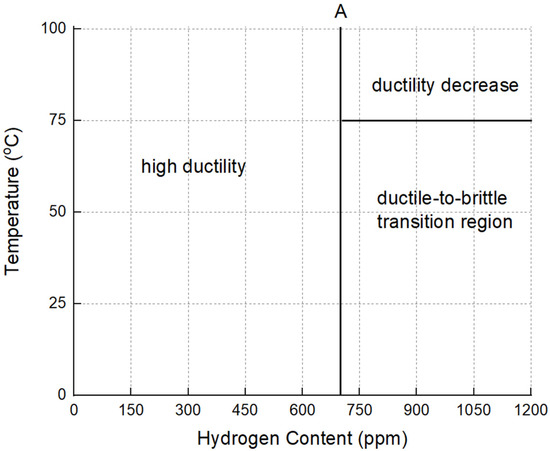
Figure 9.
Deformation responses of Zircaloy-4 correlated with temperatures and hydrogen levels. Line A denotes a hydrogen content of 700 ppm H.
4.3. Elongation Behavior of Zricaloy-4
EL is commonly recognized as an indicator of ductility. Specifically, uniform EL refers to the strain at which peak stress is achieved on an engineering stress–strain curve. This metric denotes a material’s capacity to undergo consistent deformation across its entirety, without the appearance of localized strain concentrations. A high value of uniform EL indicates superior ductility, reflecting the material’s ability to experience plastic deformation prior to reaching its breaking point [30]. Non-uniform EL describes the strain that manifests inconsistently across a material’s length during deformation. This type of EL is marked by specific regions where strain is concentrated, suggesting an uneven spread of deformation. Zirconium alloys, irrespective of their hydride content, can display both types of deformations—uniform and non-uniform—during tensile testing. For unhydrided alloys, impurities play a significant role. Meanwhile, for those containing hydrides, factors such as the spatial distribution of hydrides, the concentration of hydrogen, and the particular testing conditions come into play.
Figure 4 displays the complete EL of the specimens after tensile tests. To further understand the changes in uniform and non-uniform EL of Zircaloy-4 based on testing temperatures and hydrogen content, Table 2 provides specific EL values for both unhydrided and hydrided specimens with hydrogen contents of 700 and 1200 ppm H tested at four different temperatures. In unhydrided specimens, an increase in temperature leads to a pronounced increase in total EL. This rise is primarily attributed to the growth in non-uniform EL, even as uniform EL shows a marginal decline. Such behavior underscores that non-uniform EL is predominant across all temperatures, pointing to localized strain concentrations within the material.

Table 2.
Elongation variations as a function of hydrogen concentration and temperatures.
For hydrided specimens with a hydrogen content of 700 ppm H, as the temperature rises, the uniform EL varies between 5.9% and 7.3%. In contrast, the non-uniform EL shows a more pronounced rise, ranging from 11.8% to 31.7%. A similar trend is evident in the specimens with a hydrogen concentration of 1217 ppm H. Here, the total EL indicates a substantial growth. This growth is primarily attributed to the rise in non-uniform EL from 1.3% to 15.6%, while the uniform EL remains relatively stable. Such observations emphasize that, across all temperatures, non-uniform EL is the prevailing factor, suggesting the material undergoes localized strain concentrations.
As testing temperatures rise, there may be an increase in the number of hydrogen atoms re-dissolving from the precipitated hydrides within Zircaloy-4. It has been noted [19] that the presence of hydrogen at dislocations can diminish the resistance to their movement. Consequently, with hydrogen present, dislocations traverse more freely, resulting in pronounced localized plastic deformation. Such heightened plasticity can manifest as localized zones of intense strain, as highlighted by Robertson et al. [19].
To assess the influence of hydrogen content on EL, the specimens tested at room temperature were analyzed. Data from Table 2 reveal that with an increase in hydrogen concentration, there is a modest reduction in uniform EL, dropping from 11.5% to 7.1%. In contrast, the non-uniform EL experiences a more pronounced decrease, plummeting from 21.7% to 1.3%. This behavior can likely be ascribed to the augmented presence of hydrides, potentially causing the hydrided specimens to fracture prematurely, even before strain localization can manifest.
5. Conclusions
Zircaloy-4 sheets underwent uniform hydrogen charging at four distinct concentrations: 500, 700, 850, and 1217 ppm H. Mechanical testing was conducted on both the unhydrided and the hydrogen-charged specimens across temperatures from 25 °C to 100 °C. Fracture surfaces of these specimens were analyzed using scanning electron microscopy (SEM). Based on this study, the following conclusions are derived:
- (1)
- A ductile-to-brittle transition was observed in specimens with hydrogen content ranging between 700 and 850 ppm when tested at temperatures of 25 °C, 50 °C, and 75 °C. For tests conducted at 100 °C, there was a gradual decrease in the reduction in area as hydrogen content increased from 0 to 1217 ppm H.
- (2)
- At 25 °C, the ultimate tensile strength (UTS) of Zircaloy-4 shows a linear increase as hydrogen concentration rises from 0 to 1217 ppm H. However, at higher temperatures, the UTS behavior becomes more complex, with initial increases, followed by reductions, and then subsequent increases again, particularly in the hydrogen concentration ranges of 500–700 ppm H and 500–850 ppm H.
- (3)
- Elongation (EL) in hydrided specimens is affected by both temperature and hydrogen concentration. As the hydrogen concentration rises, uniform EL experiences a discernible decline, whereas non-uniform EL undergoes even more pronounced reductions. With the increase in testing temperatures, uniform EL remains relatively stable, but non-uniform EL markedly increases, indicating enhanced strain localization.
- (4)
- Fractography results revealed that quasi-cleavage features on the fracture surface became evident when the hydrogen content reached 850 ppm H, regardless of the testing temperatures ranging from 25 °C to 100 °C.
Author Contributions
Conceptualization, H.-M.T.; methodology, H.-M.T.; formal analysis, T.-C.C.; investigation, H.-M.T. and T.-C.C.; data curation, T.-C.C.; writing—original draft preparation, H.-M.T.; writing—review and editing, H.-M.T.; visualization, H.-M.T.; supervision, H.-M.T. All authors have read and agreed to the published version of the manuscript.
Funding
This research received no external funding.
Data Availability Statement
The original contributions presented in the study are included in the article, further inquiries can be directed to the corresponding author.
Acknowledgments
The authors extend their sincere gratitude to Jia-Hong Huang from Taiwan for his valuable discussions and contributions to the manuscript.
Conflicts of Interest
The authors declare no conflicts of interest.
References
- Zhao, Z.; Morniroli, J.; Legris, A.; Ambard, A.; Khin, Y.; Legras, L.; Blat-Yrieix, M. Identification and characterization of a new zirconium hydride. J. Microsc. 2008, 232, 410–421. [Google Scholar] [CrossRef]
- Zhu, W.; Wang, R.; Shu, G.; Wu, P.; Xiao, H. First-Principles Study of Different Polymorphs of Crystalline Zirconium Hydride. J. Phys. Chem. C 2010, 114, 22361–22368. [Google Scholar] [CrossRef]
- Hu, J.; Liu, J.; Lozano-Perez, S.; Grovenor, C.R.; Christensen, M.; Wolf, W.; Wimmer, E.; Mader, E.V. Hydrogen pickup during oxidation in aqueous environments: The role of nano-pores and nano-pipes in zirconium oxide films. Acta Mater. 2019, 180, 105–115. [Google Scholar] [CrossRef]
- Suman, S. Impact of hydrogen on rupture behaviour of Zircaloy-4 nuclear fuel cladding during loss-of-coolant accident: A novel observation of failure at multiple locations. Nucl. Eng. Technol. 2020, 53, 474–483. [Google Scholar] [CrossRef]
- Neogy, S.; Srivastava, D.; Tewari, R.; Singh, R.; Dey, G.; Banerjee, S. Microstructural study of hydride formation in Zr–1Nb alloy. J. Nucl. Mater. 2003, 322, 195–203. [Google Scholar] [CrossRef]
- Varias, A.; Massih, A. Hydride-induced embrittlement and fracture in metals—Effect of stress and temperature distribution. J. Mech. Phys. Solids 2002, 50, 1469–1510. [Google Scholar] [CrossRef]
- Birch, R.; Wang, S.; Tong, V.S.; Britton, T.B. The effect of cooling rate and grain size on hydride microstructure in Zircaloy-4. J. Nucl. Mater. 2018, 513, 221–225. [Google Scholar] [CrossRef]
- Michler, T.; Schweizer, F.; Wackermann, K. Review on the Influence of Temperature upon Hydrogen Effects in Structural Alloys. Metals 2021, 11, 423. [Google Scholar] [CrossRef]
- Jia, Y.-J.; Han, W.-Z. Mechanisms of Hydride Nucleation, Growth, Reorientation, and Embrittlement in Zirconium: A Review. Materials 2023, 16, 2419. [Google Scholar] [CrossRef]
- Kulkarni, S.S.; Truster, T.; Senor, D.J.; Devanathan, R. A Crystal Plasticity Finite Element Method Modeling of Zircaloy with Hydride Phases Based on Scanning Electron Micrographs. In Proceedings of the ASME 2022 17th International Manufacturing Science and Engineering Conference, Virtual, 27 June–1 July 1 2022. [Google Scholar]
- Mcconnell, P.; Hanson, B.; Lee, M.; Sorenson, K. Extended Dry Storage of Used Nuclear Fuel: Technical Issues: A USA Perspective. Nucl. Eng. Technol. 2011, 43, 405–412. [Google Scholar] [CrossRef]
- Waldrop, K. Extended Storage Collaboration Program International Subcommittee Report: International Perspectives on Technical data Gaps Associated with Extended Storage and Transportation of Used Spent Nuclear Fuel; EPRI: Palo Alto, CA, USA, 2012. [Google Scholar]
- Camper, L.W. US NRC Interim Staff Guidance (ISG)–11, Revision 3; U.S. Nuclear Regulatory Commission: Washington, DC, USA, 2003.
- Savchuk, E.; Sokolenko, V.; Karaseva, E.; Mats, A.; Frolov, V.; Pylypenko, M. Effect of Hydrogenation on Creep and Structure Evolution of Nanocrystalline Zr1nb Alloy. Probl. At. Sci. Technol. 2023, 64–68. [Google Scholar] [CrossRef]
- Bai, J.; Prioul, C.; Lansiart, S.; François, D. Brittle fracture induced by hydrides in zircaloy-4. Scr. Met. Mater. 1991, 25, 2559–2563. [Google Scholar] [CrossRef]
- Bai, J.B.; Francois, D. Some evidence of a brittle-ductile transition of zirconium hybride between 20 and 350degC. J. Nucl. Mater. 1992, 187, 186–189. [Google Scholar] [CrossRef]
- Huang, J.-H.; Huang, S.-P. Effect of hydrogen contents on the mechanical properties of Zircaloy-4. J. Nucl. Mater. 1994, 208, 166–179. [Google Scholar] [CrossRef]
- Hsu, H.-H. An evaluation of hydrided Zircaloy-4 cladding fracture behavior by X-specimen test. J. Alloys Compd. 2006, 426, 256–262. [Google Scholar] [CrossRef]
- Robertson, I.M.; Sofronis, P.; Nagao, A.; Martin, M.L.; Wang, S.; Gross, D.W.; Nygren, K.E. Hydrogen Embrittlement Understood. Met. Mater. Trans. B 2015, 46, 1085–1103. [Google Scholar] [CrossRef]
- Birnbaum, H.; Sofronis, P. Hydrogen-enhanced localized plasticity—A mechanism for hydrogen-related fracture. Mater. Sci. Eng. A 1994, 176, 191–202. [Google Scholar] [CrossRef]
- Gajowiec, G.; Bartmański, M.; Majkowska-Marzec, B.; Zieliński, A.; Chmiela, B.; Derezulko, M. Hydrogen Embrittlement and Oxide Layer Effect in the Cathodically Charged Zircaloy-2. Materials 2020, 13, 1913. [Google Scholar] [CrossRef] [PubMed]
- Murakami, Y.; Kanezaki, T.; Mine, Y.; Matsuoka, S. Hydrogen Embrittlement Mechanism in Fatigue of Austenitic Stainless Steels. Met. Mater. Trans. A 2008, 39, 1327–1339. [Google Scholar] [CrossRef]
- Mohamed, I.; Hasan, T.; Zikry, M.A. Thermomechanical Microstructural Predictions of Fracture Nucleation of Zircaloy-4 Alloys with δ and ɛ Hydride Distributions. J. Eng. Mater. Technol. 2021, 144, 011008. [Google Scholar] [CrossRef]
- Alvarez, M.V.; Santisteban, J.; Vizcaíno, P.; Ribárik, G.; Ungar, T. Quantification of dislocations densities in zirconium hydride by X-ray line profile analysis. Acta Mater. 2016, 117, 1–12. [Google Scholar] [CrossRef]
- Qin, W.; Szpunar, J.; Kumar, N.K.; Kozinski, J. Microstructural criteria for abrupt ductile-to-brittle transition induced by δ-hydrides in zirconium alloys. Acta Mater. 2014, 81, 219–229. [Google Scholar] [CrossRef]
- Vazquez, C.; Zelaya, E.; Fortis, A.M.; Bozzano, P.B. Irradiation Hardening and Microstructure Characterization of Zr-1% Nb During Low Dose Neutron Irradiation. J. Mater. Appl. 2021, 10, 63–72. [Google Scholar] [CrossRef]
- Kim, Y.-J.; Kook, D.-H.; Kim, T.-H.; Kim, J.-S. Stress and temperature-dependent hydride reorientation of Zircaloy-4 cladding and its effect on the ductility degradation. J. Nucl. Sci. Technol. 2014, 52, 717–727. [Google Scholar] [CrossRef]
- Cinbiz, M.N.; Koss, D.A.; Motta, A.T. The influence of stress state on the reorientation of hydrides in a zirconium alloy. J. Nucl. Mater. 2016, 477, 157–164. [Google Scholar] [CrossRef]
- Aomi, M.; Baba, T.; Miyashita, T.; Kamimura, K.; Yasuda, T.; Shinohara, Y.; Takeda, T.; Limback, M.; Kammenzind, B.; Dean, S.W. Evaluation of Hydride Reorientation Behavior and Mechanical Properties for High-Burnup Fuel-Cladding Tubes in Interim Dry Storage. J. ASTM Int. 2008, 5, 1–21. [Google Scholar] [CrossRef]
- Saeidi, N.; Ashrafizadeh, F.; Niroumand, B.; Barlat, F. Evaluation of Fracture Micromechanisms in a Fine-Grained Dual Phase Steel during Uniaxial Tensile Deformation. Steel Res. Int. 2014, 85, 1386–1392. [Google Scholar] [CrossRef]
Disclaimer/Publisher’s Note: The statements, opinions and data contained in all publications are solely those of the individual author(s) and contributor(s) and not of MDPI and/or the editor(s). MDPI and/or the editor(s) disclaim responsibility for any injury to people or property resulting from any ideas, methods, instructions or products referred to in the content. |
© 2024 by the authors. Licensee MDPI, Basel, Switzerland. This article is an open access article distributed under the terms and conditions of the Creative Commons Attribution (CC BY) license (https://creativecommons.org/licenses/by/4.0/).